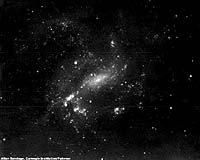 |
Huntsville AL (SPX) Sep 03, 2009 Since its discovery 45 years ago, Cygnus X-1 has been one of the most intensively studied cosmic X-ray sources. About a decade after its discovery, Cygnus X-1 secured a place in the history of astronomy when a combination of X-ray and optical observations led to the conclusion that it was a black hole, the first such identification. The Cygnus X-1 system consists of a black hole with a mass about 10 times that of the Sun in a close orbit with a blue supergiant star with a mass of about 20 Suns. Gas flowing away from the supergiant in a fast stellar wind is focused by the black hole, and some of this gas forms a disk that spirals into the black hole. The gravitational energy release by this infalling gas powers the X-ray emission from Cygnus X-1. Although more than a thousand scientific articles have been published on Cygnus X-1, its status as a bright and nearby black hole continues to attract the interest of scientists seeking to understand the nature of black holes and how they affect their environment. Observations with Chandra and ESA's XMM-Newton are especially valuable for studying the property of the stellar wind that fuels Cygnus X-1, and determining its rate of spin. This latter research has revealed that Cygnus X-1 is spinning very slowly. This puzzling result could indicate that Cygnus X-1 may have formed in an unusual type of supernova that somehow prevented the newly formed black hole from acquiring as much spin as other stellar black holes. Share This Article With Planet Earth
Related Links Chandra Understanding Time and Space
 Dartmouth Researchers Propose New Way To Reproduce A Black Hole
Dartmouth Researchers Propose New Way To Reproduce A Black HoleHanover NH (SPX) Aug 24, 2009 Despite their popularity in the science fiction genre, there is much to be learned about black holes, the mysterious regions in space once thought to be absent of light. In a paper published in the Physical Review Letters, the flagship journal of the American Physical Society, Dartmouth researchers propose a new way of creating a reproduction black hole in the laboratory on a much-tinier scale ... read more |
|
| The content herein, unless otherwise known to be public domain, are Copyright 1995-2009 - SpaceDaily. AFP and UPI Wire Stories are copyright Agence France-Presse and United Press International. ESA Portal Reports are copyright European Space Agency. All NASA sourced material is public domain. Additional copyrights may apply in whole or part to other bona fide parties. Advertising does not imply endorsement,agreement or approval of any opinions, statements or information provided by SpaceDaily on any Web page published or hosted by SpaceDaily. Privacy Statement |